Adopted by NATO forces (including the U.S Military) in 1970, the M193 5.56×45 ball ammunition performed through the Vietnam war and up to the 1980s. It was then replaced by the heavier M855 cartridge that could penetrate more and reach out longer distances.
The M855 was further refined to M855A1 which is currently in use by the military. However, it is important to analyze if the M855 is always better than the M193, or if there are certain areas where one excels the other.
M855 vs M193
Check out a quick overview of the pros and cons of the M855 and M193 cartridges and their best applications.

M855
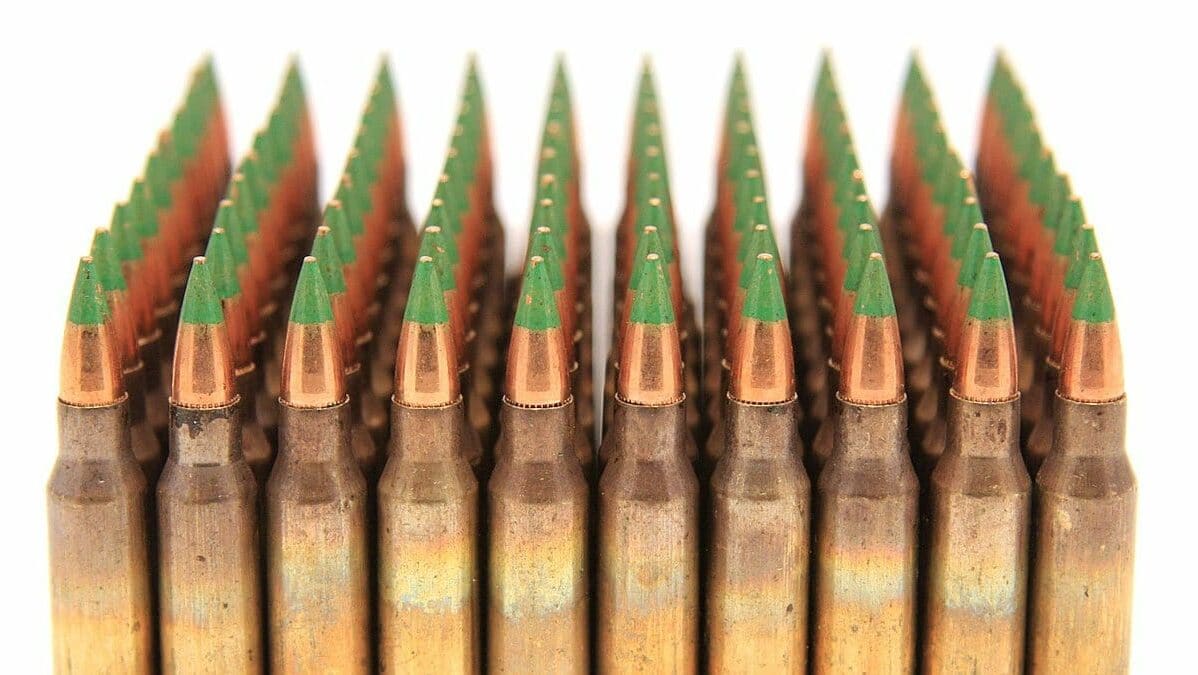
M193
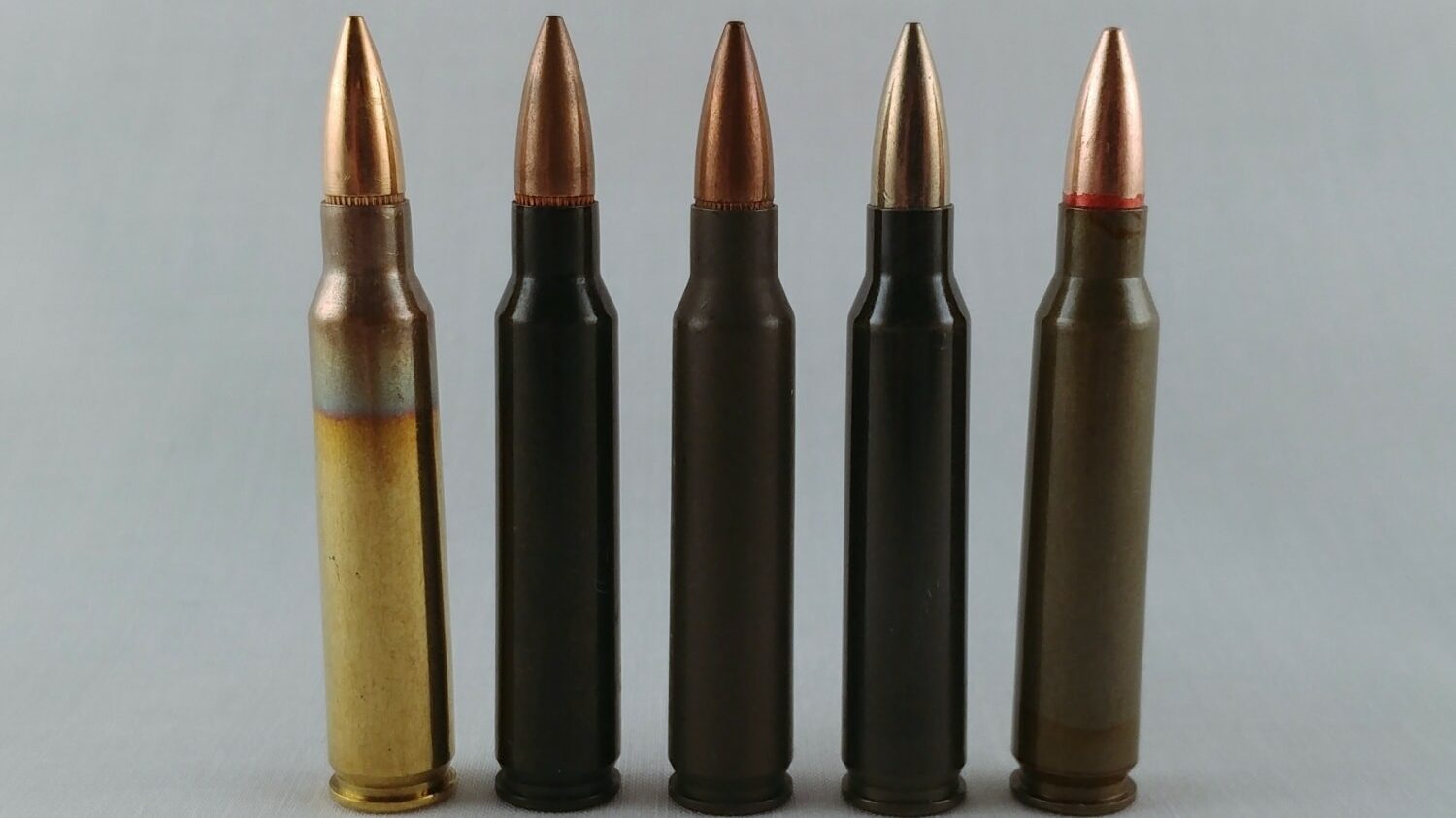
Pros
M855
Steel tip for better penetration
Versatile in terms of applications
Good stopping power up to 500 yards
Better retention of velocity a long range
Better wind resistance and resistant to fragmentation
M193
Cheap to purchase and train with
Works with a wide range of twist rates
Great for terminal effects at medium range
Cons
M855
Slightly expensive, especially match grade ammo
Damage steel targets. Banned at some shooting ranges
M193
Low penetration capability
Little resistance to the wind (low BC)
Best For
M855
The M855A1 is currently in use with the military and performs really well for combat use. Good for varminting and practice.
M193
The M193 is a lightweight and fast round which is great for varminting, range use, and home defense (if needed).
M855 Overview
The M855 is a 5.56x45mm cartridge that uses a 0.224 inches diameter bullet which is 62 grain in weight. Developed in the 1970s by FN Herstal to create a standardized round for NATO forces, it was originally known as SS109 which was later renamed to M855 in the United States Army after its adoption.
The M855 round was technically adopted to replace the M193 round (more on that later). It has better penetration and can easily penetrate 3.5mm of steel at 600 metres with its steel tip. The M855 was first used in the M16A2 rifles, with a preferable twist rate of 1:9 inches.
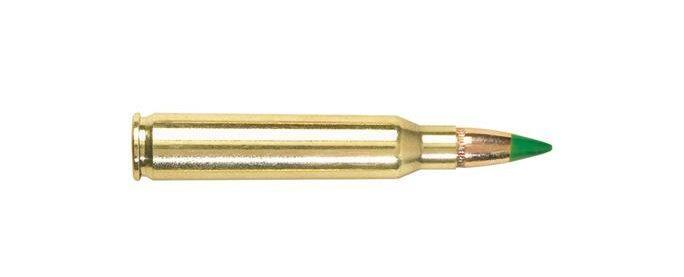
Another important factor to note is that the M855 is a ‘yaw dependent’ bullet. Which means the angle of impact is the deciding factor for penetration and damage to the target. There has been an ongoing debate about the effectiveness of the M855 ammo over a short and long range. While technically, the bullet has an effective range of 450-600 metres, the lethality and penetration capabilities begin to degrade at just 300 metres. That too with a full 20-inch barrel, and shorter barrels are even more prone to such issues.
When fired from a short-barreled rifle, the ‘yaw dependent’ bullet will not begin to yaw at around five inches of tissue penetration. Which often causes the bullet to pass through thin targets with little damage.
Now veering-off from too many technical issues, the M855 is a good bullet and the design in use today is the more refined version known as the M855A1. Introduced in June 2010, the M855A1 uses a lead-free bullet (reducing pollution) and delivers more consistent performance.
M193 Overview
The M193 or “Cartridge, 5.56mm ball, M193” is the official name of the .223 Remington cartridge after its adoption by the U.S Military in 1963. It used a copper-jacketed FMJ 55 grains round and was designed to work with 20” barrels with a twist rate of 1:12. However, shorter barrels work at a twist rate of 1:8 for this projectile.
The M193 was the second cartridge to be adopted by NATO forces after the 7.62 NATO. It uses IMR4475 powder which resulted in a muzzle velocity of 3,250 ft/s (991 m/s). It is a yaw-dependent bullet so the angle of impact is a significant factor to estimate the penetration.
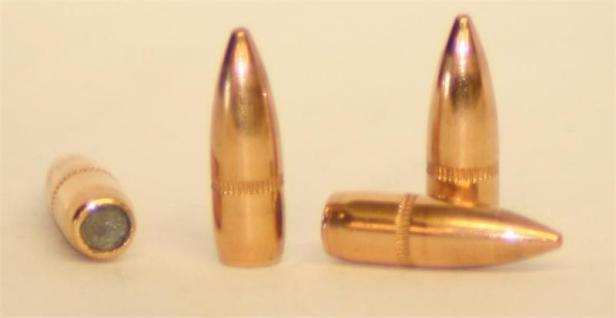
The lightweight 55-grain bullet flies at higher velocities and causes good fragmentation, however, it is always not consistent. Additionally, the inability to penetrate thin cover was an important factor that made the military replace it with the M855.
It was during the Vietnam war when the military realized that the M193 did not have significant penetrating power to pass through steel helmets or even thick brush vegetation for that matter. However, the M193 round has been found to be very effective against soft targets within a range of 150 yards. The short travel distance does not allow yaw characteristics to come into play and the fast speeds and ample energy deliver significant damage.
M855 vs M193: Cartridge Specs
Check out the cartridge specifications for the M855 and M193 cartridges to get a quick idea of their dimensions, bullet weights, and pressure ratings.
 | M855 | M193 |
|---|---|---|
| Bullet Diameter | 5.70 mm (0.224 in) | 5.70 mm (0.224 in) |
| Neck Diameter | 6.43 mm (0.253 in) | 6.43 mm (0.253 in) |
| Base Diameter | 9.58 mm (0.377 in) | 9.58 mm (0.377 in) |
| Case Length | 44.70 mm (1.760 in) | 44.70 mm (1.760 in) |
| Overall Length | 57.40 mm (2.260 in) | 57.40 mm (2.260 in) |
| Case Capacity | 1.85 cm3 (28.5 gr H2O) | 1.85 cm3 (28.5 gr H2O) |
| Max Pressure (SAAMI) | 62,366 psi | 62,366 psi |
| Typical Casing Material | Brass | Brass |
| Typical Bullet Weight (gr) | 62 gr | 55 gr |
What is clearly evident from the comparison of the M855 and M193 is that they are the same cartridge that differs only in bullet weight. The M193 is an older and lighter round compared to the M855. This difference in weight makes the M193 faster but also prone to tumbling which can cause larger wounds at the cost of stability.
The ideal twist rate for these rounds is one in eight inches. Another significant difference between these two cartridges is the type of bullets used. While the M193 is an FMJ with a lead core, the M855 uses a steel core that is far better when dealing with light armor or obstacles like car doors and similar.
However, as far as tests and data is concerned, neither of these bullets is technically armor piercing. The M855 definitely has an edge over the M193, but both these rounds are suitable for breaking up light obstacles to some degree in close-quarter fights.
The term light obstacles here means thick clothing, thin-gauge metal, brush cover, or normal car doors. Additionally, you cannot expect these bullets to pierce thick armor or bulletproof glass, even at a short range.
Also, keep in mind that since the M855 has a slight edge over the M193 in terms of penetration. Many shooting ranges have banned the use of M855 since it damages steel targets and backdrops.
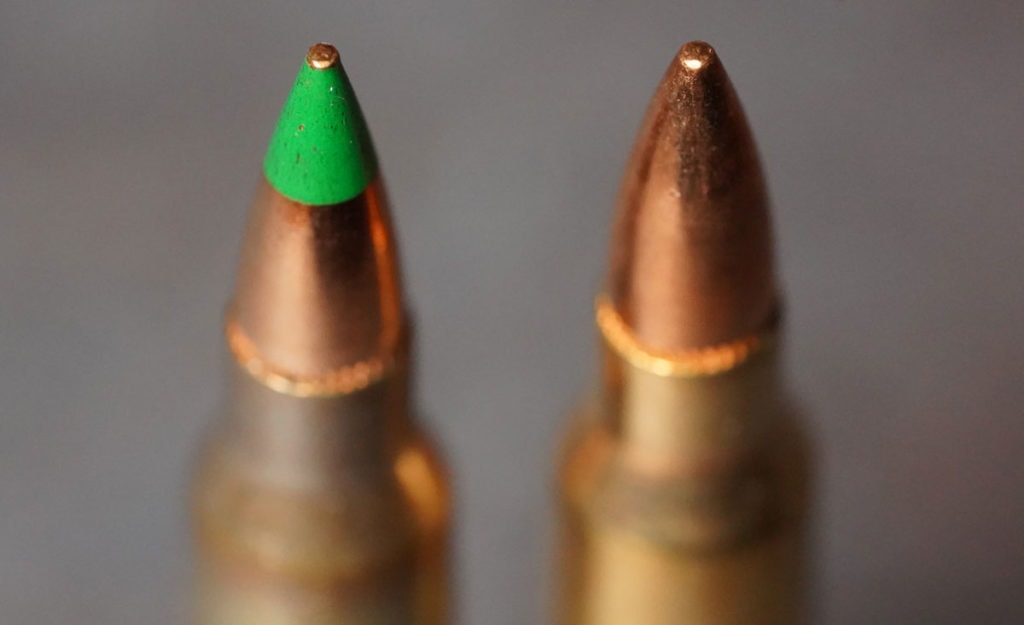
M855 vs M193: Ballistics
The ballistics of a bullet concerns the path, speed, and energy of a bullet at different stages in its flight path. The ballistics can be divided into two parts, the bullet trajectory, and the speed/energy characteristics.
The term ballistics coefficient will also come into play here, which describes the resistance of a traveling bullet against the wind. The trajectory describes the impact of the gravity on the traveling bullet which can be more or less depending upon the design, weight, and speed of the bullet.
The velocity and energy will describe how fast a bullet is moving at a specific distance and with what amount of energy. The measurement of these factors at different ranges will help us determine the stopping power of a bullet, which we will cover in the next section.
M855 vs M193: Trajectory
Check out the trajectory characteristics of the M193 and M855 bullets. There are no variations in bullet weights or other factors because the major factor of differentiation between these cartridges is their bullet weight.
M193
| 18” barrel / BC 0.246 / 55 grains | Drop (inches) |
|---|---|
| 100 yds | 0″ |
| 200 yds | 3″ |
| 300 yds | 12.1″ |
| 500 yds | 57.9″ |
M855
| 18” barrel / BC 0.349 / 62 grains | Drop (inches) |
|---|---|
| 100 yds | 0″ |
| 200 yds | 3″ |
| 300 yds | 11.8″ |
| 500 yds | 51.8″ |
The M193 and M855 differ by just seven grains in weight. While that does not seem much, the difference in trajectory increases as the range of estimation increases. What is clear from the comparison is that the difference in trajectory is quite menial up to a distance of 300 yards. However, at a range of 500 yards, the difference in drop comes out to be around six inches.
Although that does not seem too much, the heavier M855 bullet has a slight advantage that cannot be overlooked. Additionally, this difference will further increase along with the range. This is generally not a big issue because the effective range of these cartridges is under 800 yards.
The M855 has a better ballistic coefficient bullet compared to the M193. Which makes it more stable against wind deflection and hence slightly more accurate on a windy day. As far as the trajectory of these two bullets is concerned, you are less likely to notice any significant difference unless your purpose is competitive shooting at long distances.
M855 vs M193: Velocity & Kinetic Energy
The velocity and kinetic energy factors define the speed of movement and the amount of energy carried by a bullet (also known as foot pound energy) at a certain range.
M193
| 18” barrel / BC 0.246 / 55 grains | Velocity | Kinetic Energy |
|---|---|---|
| 100 yds | 2,772 ft/s | 939 ft.lbs |
| 200 yds | 2,412 ft/s | 711 ft.lbs |
| 300 yds | 2,080 ft/s | 528 ft.lbs |
| 500 yds | 1,506 ft/s | 277 ft.lbs |
M855
| 18” barrel / BC 0.349 / 62 grains | Velocity | Kinetic Energy |
|---|---|---|
| 100 yds | 2,749 ft/s | 1,040 ft lbs |
| 200 yds | 2,493 ft/s | 856 ft.lbs |
| 300 yds | 2,252 ft/s | 698 ft.lbs |
| 500 yds | 1,810 ft/s | 451 ft.lbs |
The M193 is a slightly faster bullet when compared to the M855. While the former leaves the barrel at about 3,150 fps, the latter leaves the barrel at 3,025 fps. At about 200 yards, the difference in muzzle velocity between these two bullets is very little. However, as the distance increases beyond that mark, the difference begins to increase. With its heavier bullet, the M855 retains more velocity with increasing range.
Talking about the energy characteristics, only the M855 retains an energy greater than 1,000 fpe at 100 yards. The M193 bullet has only 939 fpe of energy at 100 yards which is quite insignificant for a medium-sized game. Additionally, the fast-paced bullet and yaw characteristics and unpredictable penetration make the M193 not very suitable for most hunting applications.
The M855 round retains more energy with increasing distances due to its heavier bullet. On the other hand, the M193 being a lightweight bullet drops to just 528 fpe of energy at 300 yards and 277 fpe of energy at 500 yards. However, comparing the numbers closely, both these rounds are quite lethal in defensive roles up to a distance of 300 yards.
M855 vs M193: Stopping Power
The stopping power of a bullet defines its ability to incapacitate a living target as quickly as possible. Bullets with the best stopping power take lesser rounds to kill as compared to those with lesser stopping power. Factors like sectional density and momentum will help us understand this in a deeper and more technical perspective.
M855 vs M193: Momentum & Sectional Density
The sectional density of an object is obtained by dividing the weight of a bullet to its diameter. The SD of a bullet is the measure of its penetration capability. For example, between a slim and a fat bullet of the same weight, the slimmer bullet will deliver better penetration because it concentrates the force on a smaller area.
This is like hitting a wooden plank with a nail and a hammer. Due to the smaller cross-sectional area, the nail concentrates the force on a smaller area and penetrates deeper. Talking about numbers, the higher the value of sectional density for a bullet, the more suitable it is for bigger game animals.

On the other hand, momentum defines the amount of inertia that is carried by a moving object. In simpler terms, it describes the effectiveness of the transfer of force from the moving bullet to the impacting object. The higher the value, the more impacting force.
M193
| 18” barrel / BC 0.246 / 55 grains Sectional Density: 0.157 | Momentum |
|---|---|
| 100 yds | 21 lb-ft/s |
| 200 yds | 18 lb-ft/s |
| 300 yds | 16 lb-ft/s |
| 500 yds | 11 lb-ft/s |
M855
| 18” barrel / BC 0.349 / 62 grains Sectional Density: 0.177 | Momentum |
|---|---|
| 100 yds | 24 lb-ft/s |
| 200 yds | 21 lb-ft/s |
| 300 yds | 19 lb-ft/s |
| 500 yds | 16 lb-ft/s |
The M193 bullet has a sectional density of 0.157 and the M855 has a sectional density of 0.177. Here’s an idea of the general norms for the appropriate SD for killing different sized animals. Bullets with SD less than 0.200 are considered adequate for hunting class 1 game that includes varmints and other smaller game.
Bullets with SD 0.200 to 0.250 are suitable for a Class 2 sized game (deer, pronghorns, even humans) and anything above 0.250 is suitable for bigger game like elk or moose. The SD’s of both these bullets makes them inadequate for hunting even medium-sized game. In fact, it is also illegal to hunt deer with .223/5.56 rifles in almost every state.
The design of the bullet does have a say on penetration and fragmentation, but both of these are FMJ bullets and also yaw dependent. Additionally, no matter what the technical data says, both these rounds are effectively capable of killing bad guys or the military won’t be using them.
Talking about momentum, the M855 definitely has an edge over the M193. That is due to its weight and better SD that it keeps more momentum at increasing range. Additionally, both these bullets are good out to 200-300 yards for combat applications.
M855 vs M193: Use Cases & Effective Range
Okay, so after all the technical stuff let us summarize the real-life applications of these two cartridges.
Hunting Applications
As far as hunting is concerned, either of these rounds is a good choice to pick off varmints and small game animals like coyotes or prairie dogs. The .223 caliber bullet packs enough punch to impeccably dispatch a coyote out to 300 yards. The .223 bullet is banned in most states for hunting deer but there are exceptions. Additionally, these bullets can be used to hunt down small hogs due to their tumbling and fragmentation characteristics.
Talking about the medium or big-sized game, the M855 and M193 are fairly inadequate for a clean kill. While getting the perfect shot at the right spot will kill, that is just a probability in many cases.

Competitive Shooting
The M855 and M193 can be a great choice of bullets for competitive shooting. In fact, they are used in NRA highpower and 3-gun competitions by many people. In fact, the .223 round is also an F-class rated caliber and is used by many shooters for such long range events. The effective range for both these bullets is generally apt within the 700 yards range.
However, in expert hands on a rifle with an apt twist rate and design, these bullets can push out to 1,000 yards. Although preferring them for a distance that long is not very logical as there are many other viable options available.
Home Defense and Tactical
Tactical applications are by far the best use you can find for these two cartridges. The M193 and M855 are the basic issue cartridges for the NATO forces and have been used for decades to fight wars with good effect. These rounds have been used to clear room in CQB engagements and have performed really well.
But before you plan on using these rounds for home defense, it is better to analyze their penetration capabilities. Like I said in the ‘stopping power’ section, these bullets exit the muzzle at supersonic speeds and will penetrate light objects like drywall, ply, or thin wooden sheets at close range.
If penetration is a concern, the M193 will be a better choice in my opinion because under-penetration is the reason this round was phased out from the military service after the Vietnam war.
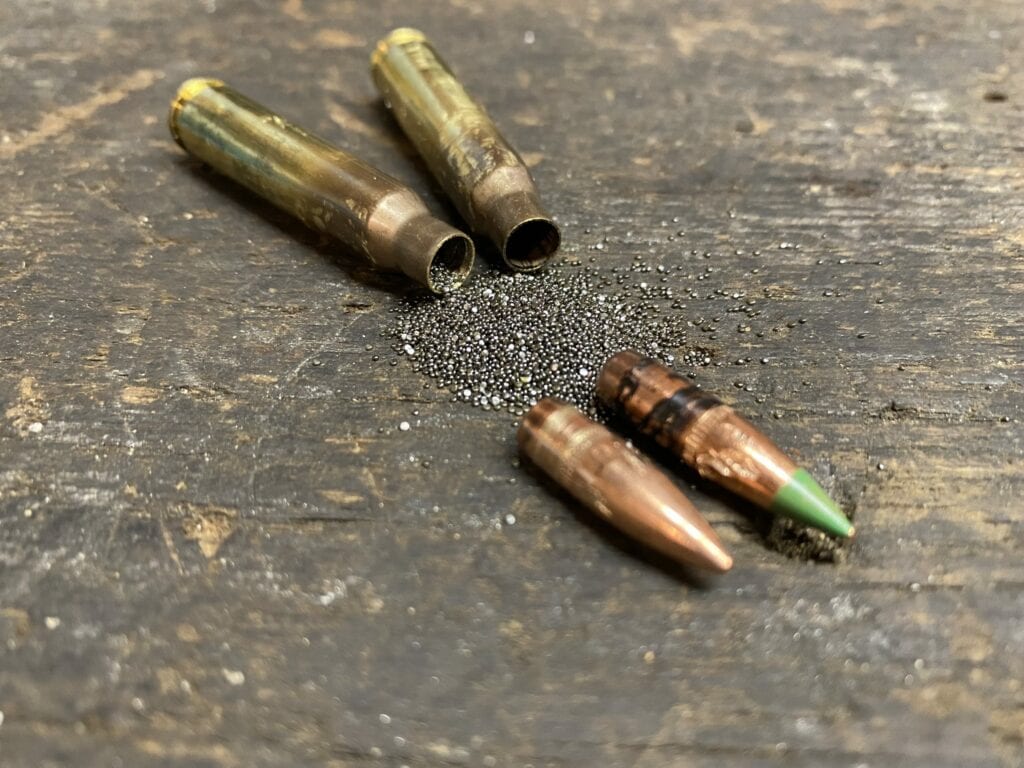
Range Practice
Any of these two rounds will be a great choice for range practice. There is a wide range of pricing options available and being a standard issue military ammo, there are many opportunities of finding milsurp ammo for the M855.
The M855 can cost anywhere between $0.50 for low grade to $1.5 per round for match-grade ammo. The M193 is slightly cheaper compared to the M855 due to its lighter weight and is generally a more economical option for range practice and mag dumps.
M855 vs M193: Costs, Availability, & Compatibility
After evaluating the performance and use cases, let’s talk about the costs and compatibility of these rounds.
.223 is Cheap and Abundant
The .223/5.56 is one of the most selling rifle cartridges in North America. This ammunition is always in good supply and this supply-demand ratio keeps the price in check. However, this extreme popularity also means that these are the first cartridges to disappear from market shelves when panic buying starts. Like we saw during the Covid-19 lockdowns when commonly used ammunition became rarer than unicorns in a forest in some places.
Anyways, being a commonly used cartridge means there will always be some supply or any other options to buy ammo. However, I will still suggest you store backup ammunition. The M193 and M855 can be easily found among online and offline stores. Hunting or range grade ammo will always be cheaper, but be ready to pay high prices for match grade ammo.
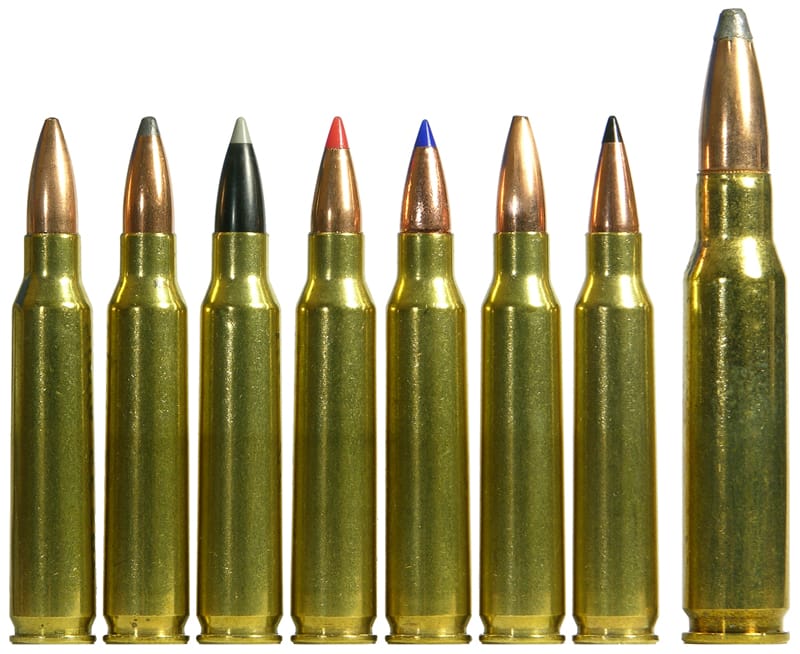
Literally a Ton of Rifle Options
There are perks of being the most popular caliber in America. The AR-15 platform has by far the most rifle options and the biggest market for aftermarket accessories and upgrades. From simple bolt action rifles to highly tactical sniper-grade rifles with a lot of rail space and accessories, there are a lot of options to choose from.
Bottom Line
The M193 is a 5.56×45 NATO round using a 55-grain bullet and was developed in the early 1970s as the supporting round for 7.62 NATO cartridges. It is a lightweight round suitable for close ranges and does not cause too much damage at longer distances. The M855 is also a 5.56×45 NATO round that uses a 62-grain bullet that retains more velocity and energy over longer distances.
The M855 has been upgraded to M855A1 by the U.S Military and is the basic issue ammo for soldiers. The M855 definitely has an edge over the M193 in terms of stopping power, but the M193 is more lightweight and cheaper to buy.
People Also Ask
Take a quick peek at the answers to some commonly asked questions when comparing the M193 and M855.
Yes, the M855 62-grain rounds are better than the M193 55-grain rounds due to their better penetration, trajectory, energy, and effective range. The M193 is the original 5.56 NATO cartridge which was upgraded with the heavier M855 bullet in the 1980s.
In my opinion, the M193 is a viable cartridge for home defense applications if you have the right kind of walls and ample space around your home’s vicinity. The M193 is great for ranges within 100 yards and delivers amazing fragmentation and the yaw dependent design means it has a better probability of stopping against barriers.
Yes, the military uses M855 ammo and switched to a more advanced version in June 2010 which is known as M855A1 which is more prevalent compared to the older version. However, all other NATO countries use the M855 as their standard issue rifle ammo.
Yes, the M855 is totally legal to own. There was a very hot debate going on around 2015 when the government was trying to brand the M855 ‘green tip’ ammo as armor-piercing and put it under the 1986 assault weapons ban. But some ambiguation in the definition of AP rounds and a few other factors prevented this from happening.
No, the M855 is not an armor-piercing round. Technically, the steel tip of the bullet does help with breaking through light protective armor (under class II) and barriers, but it is certainly not an AP round.


